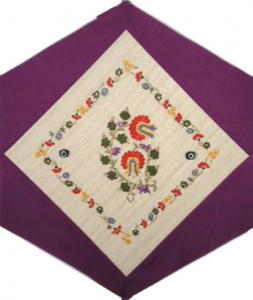Turkey

The Block
Stylized tulips atop golden branches laden with leaves and buds draw the eye to the centre of this block based on a design by Daphne Uras. Tulips have great religious and cultural significance for Turkey and are a prevalent motif in their embroidery. The flower, indigenous to the country, was introduced to Holland by the Turks in the early 16th century. A variety of blooms embroidered by Ertan Uras, typical of the fine works patiently created by young girls and women, frames the centre.
A national art form that dates back to the Ottoman Empire, embroidery was historically more than a means of decoration; it was also a communication tool by which messages, that the sender dared not put into words, were sent to others. Particular colours and motifs, many of which had specific names, were incorporated into scarves, waistbands, coverlets and carpets to express, among other things, feelings of love, anger or happiness.
Today the art is actively being revived. Many cooperatives teach young women to embroider according to old traditions thus providing them the opportunity of contributing to the family. Embroidered items, an important cultural aspect, accompany Turks from cradle to grave. Some are used only for special ceremonies; births, weddings, and in the end, placed on coffins as they are carried to the cemetery. A typical blue and white ‘Evil Eye’ flanks the flowers. The Turkish Talisman, believed to have special powers of protection and good fortune, is pinned to the right back shoulder of a newborn’s garment for protection against people’s evil wishes.
Cultural Profile
Turkey was once the center of the Ottoman Empire, which reached from Algiers to Bagdad and from the south of Egypt to the doorstep of Vienna at its greatest extent during the 17th century. Today, Turkey is located partially in both Europe and Asia, forming a bridge between the two continents. The European portion is comprised of Thrace, while Anatolia, also known as Asia Minor, makes up the Asian part. Istanbul is the only city in the world that lies across two continents, and its skyline of palaces, bazaars, and humble houses is shaped by over 400 mosques. The most famous is the 17th century Blue Mosque––the only mosque on the planet with six minarets. Turkey’s tallest mountain, Mount Agri (Ararat) is believed by many to be the spot on which Noah’s Ark landed following the great flood. The main ethnic groups are Turks, Kurds, Arabs, Jews, Armenians and Greeks. The official language is Turkish, although Kurdish, Arabic and other minority languages are also spoken.
The culture of Turkey, just like its territory, straddles two mindsets, drawing from the East just as much as from the West. For example, though the majority of people adhere to Islam, the country is secular, and religious garments are not allowed in public buildings or schools. Various cultural elements were drawn from the ethnic groups who were part of the Ottoman Empire and have been adapted to Turkish culture, while typical Turkish traditions have come to be known around former parts of the Empire. Turkish coffee, Turkish delight, syrup-soaked tulumba and doner kebab have been adopted around the world as favourite foods, while the Turkish carpet has become a sign of wealth in homes across the globe.
Textile arts in Turkey have been practiced to a degree of high quality. During the imperial era, embroidery was particularly prized by both the richest and the humblest of people, and was used to embellish clothes, household items, leather items, and even unusual items such as ceremonial wooden shields. The Turkic people, originating in Central Asia, were nomadic and carpet-making was a skill they prized highly. They no doubt brought with them this skill as they expanded into present-day Turkey in the 11th century. During Medieval times, Marco Polo sang the praise of Turkish rugs, saying he had never seen such beautiful colours, and Europe suddenly couldn’t get enough of Turkish carpets. Originally made of wool and cotton, and also of silk starting in the 20th century, carpets and prayer rugs, or kilims, are usually made by women, whose skills are passed down from one generation to the next. Cotton, linen, silk and wool, especially the fine wool coming from the area around Ankara (previously called Angora) are all readily available in the country, making fiber art a Turkish specialty. Other crafts include the making of tiles, pottery, knives, leatherwork, jewellery, glass, metalwork and the Meerschaum tobacco pipes carved into human and animal shapes.
Listening to traditional music and folksingers is a popular pastime in Turkey. Singers are often accompanied by such instruments as the bağlama, a stringed instrument, a kaval (a type of lute), a Tulum (a bagpipe), a ney (a type of flute), or a kemence (like a violin).
Turkish immigration to Canada began as early as the 1880s, but it was not until between 1956 and 1975 that the first substantial group arrived. It included a large number of professionals, such as engineers and doctors, who to this day remain an important and influential part of the Turkish-Canadian community. The largest groups of Turks settled in Ontario and Québec, with smaller concentrations in Alberta and British Columbia. Organizations, such as the Toronto’s Canadian Turkish Friendship Association, the Turkish Culture and Folklore Society of Canada (founded in 1976), and the Federation of Canadian Turkish Associations have been established, as well as the Turkish radio program, Radyo Merhaba (the largest Turkish organization in Canada with over 1,000 members). More recently Turks have been coming to Canada as both political and economic refugees fleeing unrest in their homeland. They are active in all sectors of Canadian society, and there are over 55,000 Turks now living in Canada.
Sponsor: Wendy and Les Wert
